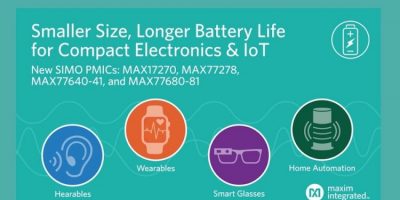Single-inductor, multiple-output power-management architecture halves size for IoT devices
Battery life can be extended and device size reduced with six low-power power management integrated circuits (PMICs) from Maxim Integrated Products. The MAX17270, MAX77278, MAX77640/MAX77641 and MAX77680/MAX77681 PMICs help to reduce the power-management footprint by up to 50 per cent for space-constrained products such as wearables, hearables, sensors, smart-home automation hubs and IoT devices. They are claimed to increase the overall system efficiency by nine per cent compared to the closest competitive solution, while also reducing heat dissipation; this is particularly important for wearable products that make contact with skin.
The control architecture in the MAX17270, MAX77278, MAX77640/MAX77641 and MAX77680/MAX77681 PMICs allows a single inductor to serve as the critical energy-storage element for multiple, independent DC-rail outputs. This allows engineers to reduce the number of bulky inductors in designs, improving efficiency, shrinking form factor and reducing heat dissipation. In addition, the low quiescent current of the PMICs plays an important role in extending battery life. With the intrinsic buck-boost operation of the PMICs, the power rails can operate over a battery’s entire range.
The MAX17270 is 50 per cent smaller than previous-generation SIMO-only solutions. The SIMO buck-boost converter reduces the number of inductors and ICs that are required for a power tree. Its quiescent current of 850nA for one SIMO channel and 1.3 microA for three SIMO channels is claimed to be the lowest in the market and helps extend battery life of end devices. In addition, the product’s low power consumption prevents overheating and reduces frequent charging cycles for wearables and hearables. They are available in TQFN and WLP package options.
The low power MAX77278 provides three buck-boost regulators with independent voltage outputs (0.8 to 5.25V out), 16 microA operating quiescent current/300nA standby current and flexible power sequencing. The device is also a charger for small Li+ cells (7.5 to 300mA CC range). It includes an adjustable 425mA current sink for an LED, eight general-purpose I/O pins and a 3.7125 to 5.3V, 50mA low-noise low-dropout regulator (LDO) with fixed headroom control in a package as low as 24mm². The PMIC’s I²C interface allows an applications processor to monitor the status and control power management. The MAX77278 is suitable for remote controls, health and fitness monitors, body cameras and IoT applications.
The MAX77640/MAX77641 low power SIMO PMICs feature three buck-boost regulators, a low-noise 150mA LDO, a general purpose I/O output port, a triple current sink for an RGB LED array and flexible power sequencing. Operating current is just 5.6 microA and shutdown current is 300nA. Available in a 16mm² package size, the MAX77640 and MAX77641 are suitable for applications with a built-in charger in areas like wearables, fitness and health monitoring and IoT.
The MAX77680/MAX77681 SIMO PMICs provide three buck-boost regulators, 3.0 microA operating quiescent current, 300nA shutdown current and flexible power sequencing. Total solution size is only 15.5mm². The MAX77680 and MAX77681 are suitable for more minimalistic platforms that require streamlined resources, such as Bluetooth headsets/earbuds and miniaturised IoT devices (rings, watches, e-pens).
The MAX17270EVKIT#, the MAX77278EVKIT#, the MAX77680/MAX77681EVKIT# and the MAX77640/MAX77641EVKIT# are available now.




